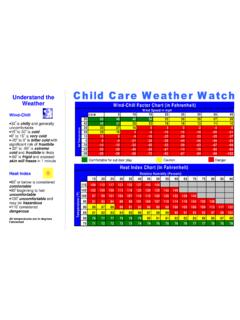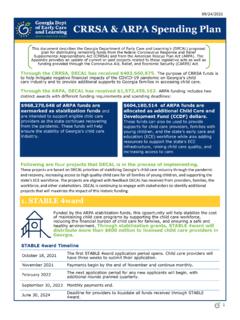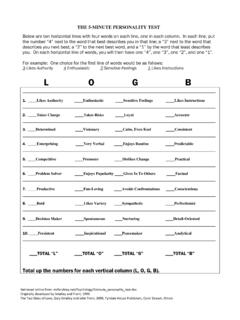Transcription of COMMON INFECTIOUS ILLNESSES - Bright from the Start
1 Disease, illness or organismIncubation period (How long after contact does illness develop?)How is it spread?When is a child most contagious?When can a child return to the childcare center or school?Report to county health department*How to prevent spreading infection (management of conditions)**Eye, ear, nose, throat and chestTo prevent the spread of organisms associated with COMMON infections, practice frequent hand hygiene, cover mouth and nose when coughing and sneezing, and stay up to date with , bronchitis, COMMON cold, croup, ear infection, pneumonia, sinus infection and most sore throats (respiratory diseases caused by many different viruses and occasionally bacteria)
2 VariableContact with droplets from nose, eyes or mouth of infected person; some viruses can live on surfaces (toys, tissues, doorknobs) for several hoursVariable, often from the day before symptoms begin to 5 days after onsetNo restriction unless child has fever, or is too uncomfortable, fatigued or ill to participate in activities (center unable to accommodate child s increased need for comfort and rest)NOCold sore (Herpes simplex virus)2 days to 2 weeksDirect contact with infected lesions or oral secretions (drooling, kissing, thumb sucking)
3 While lesions are presentWhen active lesions are no longer present in children who do not have control of oral secretions (drooling); no exclusions for other childrenNOAvoid kissing and sharing drinks or (Pink eye)Variable, usually 24 to 72 hoursHighly contagious; contact with secretions from eyes of an infected person or contaminated surfacesDuring course of active infectionOnce treatment beginsNODiphtheria (Corynebacterium diphtheriae bacteria)1 to 10 days (usually 2 to 5 days)Contact with droplets and discharge from eyes, nose, throat or skin of infected person.
4 Rarely, transmission may occur from skin lesions or articles soiled with discharges from lesions of infected personWithout antibiotic therapy, usually less than 2 weeks, but occasionally as long as 6 months. A child is no longer INFECTIOUS after treatment with appropriate antibioticsAfter 2 negative cultures are taken at least 24 hours apartYEST imely immunization beginning at 2 months old; booster dose of Tdap is recommended at 11 years old; all adults should receive a booster of Tdap. Close contacts, regardless of immunization status, should be monitored for 7 days for evidence of disease and started on antimicrobial prophylaxis; immunizations should be brought up to date, if (the flu) (influenza virus)1 to 4 daysHighly contagious; contact with droplets from nose, eyes or mouth of infected person; virus can live on surfaces (toys, tissues, doorknobs) for several hoursVariable; from 24 hours before onset of symptoms to 7 days after onset.
5 Can be prolonged in young childrenNo fever for 24 hours without the use of fever-reducing medicinesNO for individual cases; YES for influenza-associated deaths or novel influenza A virus infectionsAnnual influenza vaccine recommended for everyone 6 months and older (with rare exception).Mononucleosis (Mono) (Epstein-Barr virus)30 to 50 daysContact with the infected person s salivaIndeterminateNo restriction unless child has fever or is too uncomfortable, fatigued or ill to participate in activities (center unable to accommodate child s increased need for comfort and rest)NOAvoid kissing and sharing drinks or (mumps virus)12 to 25 days (usually 16 to 18 days)
6 Contact with saliva or mucus from the mouth, nose or throat of an infected person1 to 2 days before symptoms appear through 5 days after onset5 days after onset of parotid gland (neck) swellingYESA void sharing beverage containers, eating utensils and kissing. Timely immunization beginning at 12 months old. Vaccination of contacts may be syncytial virus (RSV)2 to 8 days (4 to 6 days is most COMMON )Highly contagious; contact with droplets from nose, eyes or mouth of infected person; virus can live on surfaces (toys, tissues, doorknobs) for several hoursVariable; from the day before onset of symptoms until 3 to 8 days after or longer.
7 May last up to 3 to 4 weeksNo fever for 24 hours without the use of fever-reducing medicinesNOPractice meticulous hand hygiene and avoid contact with respiratory throat (Group A Streptococcus bacteria)2 to 5 daysContact with droplets from nose and mouth; close, crowded contactHighest during acute infection; no longer contagious within 24 hours after antibioticsAfter 24 hours of antibiotic treatmentNOAvoid close contact with symptomatic persons until completion of 24 hours of antimicrobial (TB) (mycobacterium tuberculosis)2 to 10 weeks (risk of developing disease is highest 6 months to 2 years after infection)Airborne inhalation of droplets from nose and mouth of diseased person (children usually contract TB from close contact with a diseased adult)
8 Usually only a few days to a week after effective drug therapy. Children younger than 10 years are rarely contagiousFor active disease, once determined to be non- INFECTIOUS , therapy started, symptoms diminished and adherence documented; no exclusion for latent infectionYESRisk-based screening of children may be indicated. Consult with local health department. Adults should undergo annual symptom and exposure screening with testing based on local risk cough (pertussis) (bordetella pertussis bacteria)4 to 21 days (usually 7 to 10 days)Contact with droplets from nose, eyes or mouth of infected person1 to 2 weeks before cough onset to completion of 5 days of appropriate antibiotic.
9 If untreated, INFECTIOUS for 3 weeks after cough onsetAfter 5 days of appropriate antibiotic treatment; if untreated, 3 weeks after onset of coughYEST imely immunization beginning at 2 months old; booster dose of Tdap is recommended at 11 years old. All adults should receive a booster dose of Tdap. Close contacts that are unimmunized should have pertussis immunization initiated. Chemoprophylaxis is recommended for all close prevent spreading infection for all GI diseases, avoid potentially contaminated beverages, food and water, and divide food preparation and diapering responsibilities among staff.
10 Gastroenteritis bacterial (vomiting and/or diarrhea) Campylobacter, C. difficile (Clostridium difficile), Shiga toxin-producing E. coli (Escherichia coli) or E. coli O157, Salmonella, ShigellaVaries with pathogen (from 10 hours to 7 days)Contact with stool from infected individual (or occasionally pets); contaminated food, beverages or water (especially raw eggs and improperly cooked meats)When diarrhea is present; pathogenic E. coli and Shigella are highly INFECTIOUS in small doses even after diarrhea resolvesShiga toxin-producing E.










